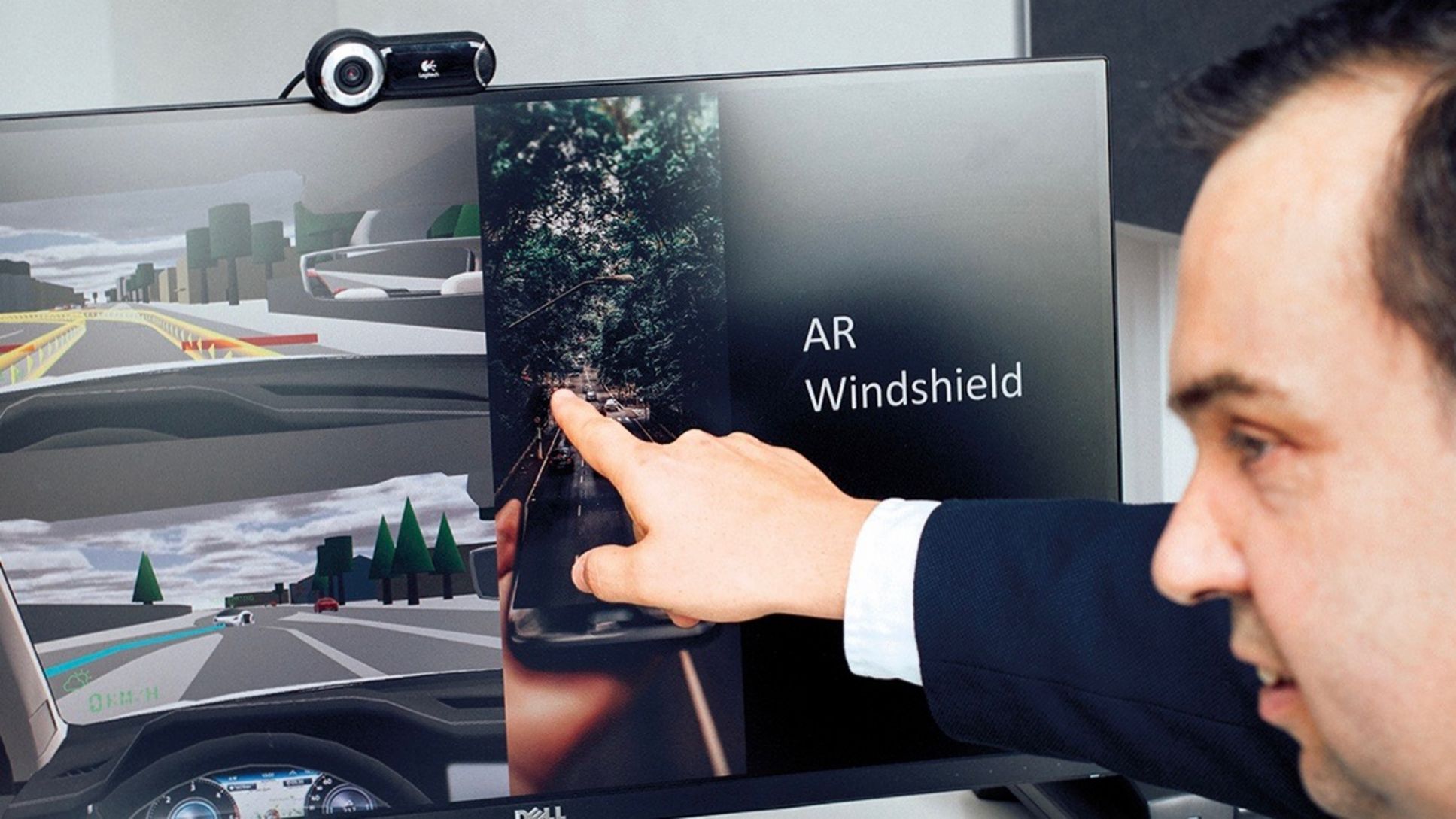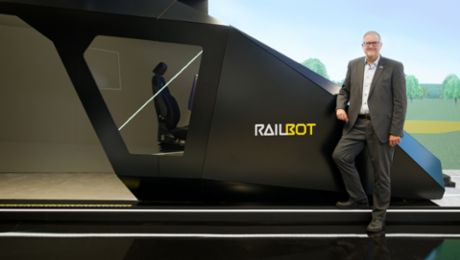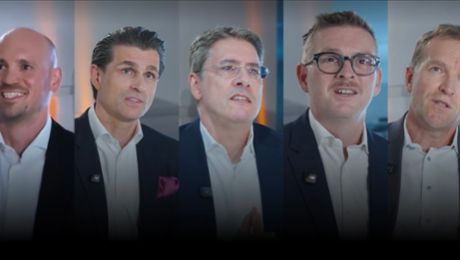Paulo Humanes, the PTV Group’s manager in charge of business development and new mobility, stands in the new mobility lab at his group’s headquarters in Karlsruhe. Featuring five monitors, a projection table, and a wall-sized screen, the room functions as a control center that can take visitors on virtual tours. First stop: Barcelona.
“What do you think, how long should passengers have to wait before being picked up by an autonomous electric car?” asks Humanes. Visitors are asked to assume the role of mayor and decide how the residents of this European metropolis should be able to get around by rapid, safe, and environmentally friendly means of transportation. “How soon in advance should they have to order the car?” And, “Should they be able to get in anywhere, at any street corner, or only at specified stops?” There’s quite a bit to decide.But when all the key data are determined, the future unfolds in front of viewers’ astonished eyes, in the form of an interactive scenario. A trip from any given point to the city center, such as the famous La Rambla shopping street? No problem. The screen on the wall shows the precise route—and what else is moving in the city at the same time.
“We are developing into a global platform for mobility management” Paulo Humanes
Developing realistic urban mobility scenarios is the core business of the PTV Group. The three letters stand for Planung, Transport, and Verkehr (traffic). “We are developing into a global platform for mobility management,” says Humanes. That includes examining not only current states of mobility but also everything that will change in the future. For example, constructing a new bridge, or holding a major event for more people than usual at a particular location, will have an impact on many other parts of a city. The same applies to new mobility providers like Uber and Moia, whose ride-sharing concepts also affect traffic. “Cities are complex and sometimes arbitrary entities,” says Humanes. Yet it is still possible to calculate how they move. “Forty years ago, PTV was already sure that technology would change mobility.” That’s when the company was founded as a spin-off of the Karlsruhe Institute of Technology (KIT). It has since grown in every way, and today is active in 128 countries and 2,500 cities. Some 15,000 people use its software.
And more than one million delivery truck drivers are guided by software that is based on simulations from PTV. Thanks to algorithms and historical data it can predict when recipients can probably be reached—and uses this point in time to calculate routes that avoid unnecessary mileage. “We lower CO₂ emissions by 40,000 tons every day by this means alone,” says Humanes. Other criteria are also considered, such as current changes in traffic patterns and specifics of the goods being delivered. Are tomatoes going to one supermarket, and frozen food to another? PTV has long since established a dominant position here. “There’s hardly a package in France that isn’t delivered without PTV optimization.” Organizers of the world’s largest sporting events also rely on the experience and expertise of this German company. As do urban and traffic planners.
“You have to look very closely at things if you want to plan the future” Paulo Humanes
“Simulations let us look into the future,” says Humanes. To illustrate this, he switches the view on the big screen to the next stop, leaving Barcelona in the future for Karlsruhe in the present. It’s 9:30 in the morning, and many streets and intersections are marked in red. “It’s rush hour, and an accident has caused a traffic jam,” notes Humanes. But with one click, the system shows different scenarios for how traffic can flow again—within ten, thirty, or sixty minutes.
Congestion is just one problem for many of the world’s big cities. Another is the quality of life in their central districts, which often have to contend with a steadily shrinking amount of space for pedestrians and recreational activities. One day the city of Lisbon began discussing this problem with PTV. Its planners wanted to make the city more attractive for pedestrians again, and commissioned a study on ways of doing so. Among other things, the study revealed that cobblestones in the city center were a problem for pedestrians—by causing many to stumble. “The analysis showed that this happened most often outside bars and restaurants,” says Humanes. The reason, however, was not inebriated patrons, but logistical practices. Many large trucks stop in front of bars to deliver crates of drinks. The trucks are too heavy for the cobblestones, and make them uneven. “You have to look very closely at things if you want to plan the future,” remarks Humanes. As a possible solution, PTV suggested that parking garages be converted to micro-delivery hubs, i.e., local distribution centers where many goods can be transferred from big trucks to smaller electric vehicles for delivery to their final destinations. “If you don’t need cars in Lisbon anymore, then you can use the parking garages for other purposes,” he adds. Their roofs can hold new bars, or be converted to public squares.
The Lisbon study used simulations with historical data and future projections to show that the city could have robotaxis, i.e., shared autonomous vehicles, to meet its transportation needs with only a fraction—just 10 percent—of the cars used today. If that were to happen, it would usher in an entirely new form and culture of mobility that would dispel the red lines on the screen in Humanes’ headquarters. The Portuguese manager is optimistic that this will in fact happen. “All over the world we’re seeing how technology is transforming mobility,” he says. And puts it in even more specific terms: “There are clear indications that PTV is changing the world.” That is the reason he moved to Karlsruhe after ten years in the English city of Newcastle—to work for sustainable, efficient, and safe transportation at PTV.
Lisbon is taking concrete steps toward a sustainable future. It has already installed 300 charging stations for e-cars, and required Uber to offer more rides in electric vehicles. At the same time, the city is lowering the fares for its public transportation system. “Mobility can be an environmentally friendly service,” says Humanes. “But there aren’t any blanket solutions.” Every city is different, and good simulations that take all eventualities into account are needed to plan for the future.
“You always have to understand the entire system,” insists Humanes. This approach protects him and his colleagues from a common fallacy, namely, that robotaxis will necessarily lower levels of traffic. “On the contrary, the danger is that more people will take cars.” After all, it’s convenient not to have to drive, and to get around without losing time in traffic jams. Lisbon’s estimated 10 percent of vehicles it will need in the future will drive day and night, in contrast to cars today, which spend an average of twenty-three hours a day parked. “That’s why we also need excellent public transportation. Simulations have to show whether new systems are feeding passengers into the metro system, or drawing them away from it.” A rapid metro system and robotaxis for the last few kilometers are good for everyone—both passengers and the environment. And that, says Humanes, is the future.
Info
Photo: Porsche Consulting




